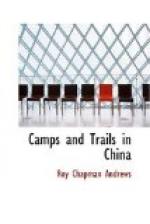CHAPTER XVII
GORALS AND SEROWS
Gorals and serows belong to the subfamily Rupicaprinae which is an early mountain-living offshoot of the Bovidae; it also includes the chamois, takin, and the so-called Rocky Mountain goat of America. The animals are commonly referred to as “goat-antelopes” in order to express the intermediate position which they apparently hold between the goats and antelopes. They are also sometimes called the Rupicaprine antelopes from the scientific name of the chamois (Rupicapra).
The horns of all members of the group are finely ridged, subcylindrical and are present in both sexes, being almost as long in the female as in the male. Although no one would suspect that the gorals are more closely related to the takins than to the serows, which they resemble superficially, such seems to be the case, but the cranial differences between the two genera are to a certain extent bridged over by the skull of the small Japanese serow (Capricornulus crispus). This species is most interesting because of its intermediate position. In size it is larger than a goral but smaller than a serow; its long coat and its horns resemble those of a goral but it has the face gland and short tail of a serow. It is found in Japan, Manchuria and southern Siberia.
The principal external difference between the gorals and serows, besides that of size, is in the fact that the serows have a short tail and a well developed face gland, which opens in front of the eyes by a small orifice, while the gorals have a long tail and no such gland.
In the cylindrical form of their horns the serows are similar to some of the antelopes but in their clumsy build, heavy limbs and stout hoofs as well as in habits they resemble goats. The serow has a long, melancholy-looking face and because of its enormous ears the Chinese in Fukien Province refer to it as the “wild donkey” but in Yuen-nan it is called “wild cow.”
The specific relationships of the serows are by no means satisfactorily determined. Mr. Pocock, Superintendent of the London Zooelogical Society’s Gardens, has recently devoted considerable study to the serows of British India and considers them all to be races of the single species Capricornis sumatrensis. With this opinion I am inclined to agree, although I have not yet had sufficient time in which to thoroughly study the subject in the light of our new material.
These animals differ most strikingly in external coloration, and fall into three groups all of which partake more or less of the characters of each other. Chinese serows usually have the lower legs rusty red, while in Indian races they are whitish, and black in the southern Burma and Malayan forms.
The serows which we killed upon the Snow Mountain can probably be referred to Capricornis sumatrensis milne-edwardsi, those of Fukien obtained by Mr. Caldwell represent the white-maned serow Capricornis sumatrensis argyrochaetes and one which I shot in May, 1917, near Teng-yueh, not far from the Burma frontier, is apparently an undescribed form.




